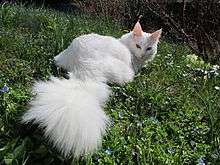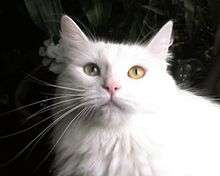Turkish Angora
The Turkish Angora (Turkish: Ankara kedisi, 'Ankara cat'[1]) is a breed of domestic cat. Turkish Angoras are one of the ancient, natural breeds of cat, having originated in central Turkey, in the Ankara region. The breed has been documented as early as the 17th century and is believed to be the origin of the mutations for both the color white and long hair. The breed is also sometimes referred to as simply the Angora or Ankara cat.[1]
| Turkish Angora | |
|---|---|
 A white Turkish Angora cat | |
| Other names | Ankara[1] |
| Origin | Turkey |
| Breed standards | |
| CFA | standard |
| FIFe | standard |
| TICA | standard |
| ACFA/CAA | standard |
| CCA-AFC | standard |
| Domestic cat (Felis catus) | |
History

Like all domestic cats, Turkish Angoras descended from the African wildcat (Felis silvestris lybica). Their ancestors were among the cats that were first domesticated in the Fertile Crescent. Cats from eastern mountainous regions of Anatolia developed into longhaired breeds like the Turkish Van and the Turkish Angora through inbreeding and natural selection.
Longhaired cats were imported to Britain and France from Asia Minor, Persia and Russia as early as the late 16th century, though there are indications that they appeared in Europe as early as the 14th century due to the Crusades . The Turkish Angora was used to improve the coat on the Persian, almost to the point of extinction. The Turkish Angora was recognized as a distinct breed in Europe by the 17th century.[2] However, there is a strong connection between Angoras and Persians. Charles Catton, in his 1788 book Animals Drawn from Nature and Engraved in Aqua-tinta, gave "Persian cat" and "Angora cat" as alternative names for the same breed.[3]
The Persian cat was developed from Turkish angora mutations by British and American cat fanciers. Although some cat associations think the Persian cat is a natural breed, in the 19th century Persians and Angoras were identical. In 1903, F. Simpson wrote in her book The Book of the Cat:[4]
"In classing all long-haired cats as Persians I may be wrong, but the distinctions, apparently with hardly any difference, between Angoras and Persians are of so fine a nature that I must be pardoned if I ignore the class of cat commonly called Angora, which seems gradually to have disappeared from our midst. Certainly, at our large shows there is no special classification given for Angoras, and in response to many inquiries from animal fanciers I have never been able to obtain any definite information as to the difference between a Persian and an Angora cat."

The Angora of the 20th century was used for improvement in the Persian coat, but the type has always been divergent from the Persian – particularly as the increasingly flat-faced show cat Persian has been developed in the last few decades.
In the early 20th century, Ankara Zoo began a breeding program to protect and preserve pure white Angora cats.[5] The zoo particularly prized odd-eyed specimens (i.e., with one blue and one amber eye); however the cats were chosen only by their color (white)—no other criterion was used. Despite the lack of selective breeding and no consideration given for the deafness problem, Ankara Zoo cats have a very similar type.
The Turkish Angora, which was brought to Canada in 1963, was accepted as a championship pedigreed breed in 1973 by the Cat Fanciers' Association.[6] However, until 1978 only white Angoras were recognized. Today, all North American registries accept the Turkish Angora in many colors and patterns. While numbers are still relatively small, the gene pool and base of fanciers are growing.
Breeders in Turkey feel that the cat fancy’s fine-boned version of their national breed is unrepresentative of the true Turkish cats, which are much sturdier. American “Turkish” Angoras may have only a minimal remnant of the original Ankara Zoo DNA and are only “purebred on paper".[7]
Appearance
.jpg)
Turkish Angora cats have long, silky coats and elegant, sinuous bodies. A younger Turkish Angora can often be mistaken for a snow weasel. Though it is known for a shimmery white coat and posh tail, Turkish Angora cats can display a variety of colors.[10] They come in tabby and tabby-white, along with black with an undercoat of chocolate brown, and lastly smoke varieties, and are in every color other than those that indicate crossbreeding, such as pointed, chocolate and lavender.[11][12]
Eyes may be blue, green, amber, yellow, or heterochromatic (e.g., one blue and one amber or green). Ears are pointed, large and wide-set. The eyes are almond shaped and the profile forms two straight planes. The plumed tail is often carried upright, perpendicular to the back.[11]
Behavior
Turkish Angora cats are playful, intelligent, athletic and involved. They bond with humans, but often select a particular member of the family to be their constant companion. They are, in turn, very protective of their person.[10] They seek to be "helpful" in any way they can with their humans, and their intelligence is at times remarkable, showing basic problem solving skills. They are easily trained, including deaf Turkish Angoras, both because of their intelligence and their desire to interact with humans.
Turkish angoras are energetic, and often seek out "high ground" (or perch) in the home. This perch is then used as a way to observe activity of the home.[10] This could include tops of doors, refrigerators, bookshelves, and other furniture. Some ride on their owners' shoulders. Their personality makes the breed desirable to certain people. They get along well in homes with other animals, children, and high activity.
Health
.jpg)
The W gene responsible for the white coat and blue eye is closely related to the hearing ability, in this and other breeds, and presence of a blue eye can indicate the cat is deaf to the side the blue eye is located, with some being totally deaf if bearing two blue eyes. However, a great many blue and odd-eyed white cats have normal hearing, and even deaf cats lead a normal life if kept indoors.
Some Turkish Angora kittens suffer from hereditary ataxia, a rare condition thought to be inherited as an autosomal recessive.[13] The kittens affected by ataxia have shaking movements, and do not survive to adulthood.
Another genetic illness that is rare but known to the breed is hypertrophic cardiomyopathy,[14] which is a cardiac condition usually found between the ages of 2 - 6, with males being affected more commonly and more severely than females. In the Maine Coon, HCM is thought to be an autosomal dominant gene and researchers are working to identify markers for this disease. However, in the Turkish Angora, the disease has not yet been studied at length primarily due to its rarity of occurrence, and is likely to result from a different mutation of genes, with a different gene location than that of the Maine Coon cat. HCM also affects many other breeds, including Ragdolls, Persians and Bengals.
Genetics

.jpg)
A genetic study of pedigree cat breeds (using DNA taken from pedigreed cats in US and Europe) and worldwide random-bred populations showed the Turkish Van as a distinct population from the Turkish Angora despite their geographical association. The Turkish Angora was grouped with the pedigreed Egyptian Mau and random-bred Tunisian cats. Turkish random-bred cats were grouped with Israeli random-bred cats while the Turkish Van was grouped with Egyptian random-bred cats.[15] However, the UC Davis only studied American cat fancy registered Angoras rather than the “true” Turkish Angora or Ankara Kedisi directly from Turkey, and especially from the Ankara Zoo.[7]
A genetic study published in 2012 [16] included a few cats imported from Turkey. The study found that ″Turkish- versus USA-originating Turkish Angoras (...) are resolved as separate breed populations[16] The American Turkish Angoras are categorized as descendants of European random-bred cats, and cats imported from Turkey ″were assigned to the Eastern Mediterranean″ group.[16]
References
- "ARTS-CULTURE - The white beauty of Ankara: Ankara Cat". Hürriyet Daily News | LEADING NEWS SOURCE FOR TURKEY AND THE REGION. Archived from the original on 2016-12-20. Retrieved 2016-12-08.
- Barbara Azan and Sandralee Rodgers. "The Turkish Angora:About This Breed". CFA inc. The Cat Fancier's Association. Retrieved 2 January 2015.
- Catton, Charles (1788). "The Persian Cat, Plate 8". Animals drawn from Nature and engraved in aqua-tinta. I. and J. Taylor.
- "The Book Of The Cat | by Frances Simpson". Chestofbooks.com. 1902-02-01. Retrieved 2013-01-26.
- "KediciWeb". Kedici.com.tr. 2011-02-24. Archived from the original on 2013-05-10. Retrieved 2013-01-26.
- "Cat Fanciers' Association: Breed Profile: Turkish Angora". Archived from the original on 29 October 2012. Retrieved 8 October 2014.
- "The Domestication of the Cat". Messybeast.com. Retrieved 21 December 2017.
- "Atatürk Forest Farm Zoo". ankarazoo.gov.tr. Ankara Zoo. Retrieved 17 September 2011.
- Loeschke, S. (November 1997). "Turkish Angoras in Ankara Zoo... or on the road investigating the Turkish Angora". erkr.de. S. Loeschke. Archived from the original on 18 July 2011. Retrieved 17 September 2011.
- Shojai, Amy (1997). For th Love of Cats. Lincolnwood, Illinois: Publications International, Ltd. pp. 108–109. ISBN 0-7853-1411-3.
- "Turkish Angora: Breed Standard Point Score" (PDF). CFA inc. Cat Fanciers Association. Retrieved 2 January 2015.
- "Breed Profile: The Turkish Angora". Retrieved 8 October 2014.
- "hosca-kal.de". Hosca-kal.de. Retrieved 21 December 2017.
- "Turkish Angora". Of Cats. 2008-06-17. Retrieved 2013-01-26.
- Lipinski, Monika J.; Froenicke, Lutz; Baysac, Kathleen C.; Billings, Nicholas C.; Leutenegger, Christian M.; Levy, Alon M.; Longeri, Maria; Niini, Tirri; Ozpinar, Haydar (2008). "The ascent of cat breeds: Genetic evaluations of breeds and worldwide random-bred populations". Genomics. 91 (1): 12–21. doi:10.1016/j.ygeno.2007.10.009. PMC 2267438. PMID 18060738.
- Kurushima, J. D.; Lipinski, M. J.; Gandolfi, B.; Froenicke, L.; Grahn, J. C.; Grahn, R. A.; Lyons, L. A. (2012). "Variation of cats under domestication: Genetic assignment of domestic cats to breeds and worldwide random-bred populations". Animal Genetics. 44 (3): 311–24. doi:10.1111/age.12008. PMC 3594446. PMID 23171373.